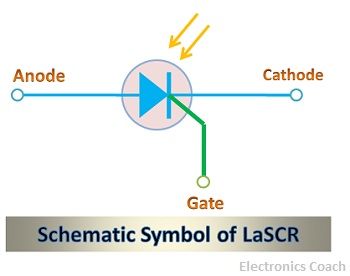Definition: LASCR or light activated SCR is a semiconductor device which turns ON when it is exposed to light. The constituent element of SCR is silicon, and it works like a rectifier, and thus, it is termed as Silicon Controlled Rectifier. The LASCR is a type of thyristor which is triggered by photons present in the light rays.
It is a three terminal device, consists of cathode, anode and gate terminal. The gate terminal is used when the electrical triggering is supplied to the LASCR. The advantage of using triggering of the thyristor by light is prevention from electrical noise disturbances. Thus, LASCR is considered to be one of the best devices.
The symbolic representation of LASCR is shown below:

Construction of LASCR
The LASCR is made up of silicon material, and the glass lens in the LASCR is used to focus the light from the external source on the semiconductor material. The silicon pellet is used in the bottom of the device, and the light intensity dislodges electrons in the semiconductor crystal and contributes to conduction.
The constructional architecture of the LASCR is described below in the diagram.

Working of LASCR
The LASCR works on the principle of photoconduction that is conduction due to photon striking the semiconductor surface. The LASCR is basically a thyristor; it is made up of semiconductor material. The light rays falling on the device are focused at one place to intensify it.
The more the intensity of light, the more will be the current through the LASCR. The internal architecture of LASCR consists of two transistors in such a way that the collector of one transistor is connected to the base of another transistor.
The light falling on the light activated SCR generates the electron from the valence band, and these electrons will enter conduction band. The electrons will move from collector of one region to base of another region, and then the cascading effect can be seen.
The best thing about Light Activated SCR is that they do not turn off even when the supply of external light is ceased. If you want to turn off the SCR, then you need to reverse the properties of electrodes.
The light-activated SCR (Silicon Controlled Rectifier) is also termed as light triggered thyristor (LTT). This is because the thyristor is triggered by the supply of light from the external source. Although, the combination of light source and the electrical signal is also used sometimes to trigger the thyristor. But in this, the electrical signal is applied through the gate terminal. And the light is incident directly to semiconductor crystal.
Operation of LASCR in the presence of light and electrical signal
The LASCR is a light-triggered device, but the combination of light signal and the electrical signal can also be used for its operation. In that case, two conditions will arise and that are as follows:-
- When the electrical signal of lower strength is applied to the gate terminal, then the intensity of the light required to dislodge electrons from the semiconductor crystal will be high.
- When the electrical signal of higher strength is applied to the gate terminal, then the intensity of the light required to dislodge electrons from the semiconductor crystal will be low.
Applications of the Light Activated SCR
- Low Power Applications: The Light activated SCR are generally used for the application which requires low power to operate. This is because power generated by SCR is low in magnitude.
- Motor Control: The Light Activated SCR finds applications in the working of Motor Control.
- Computer Applications: The components used in the computer system also require LASCR for meeting power requirements.
- Optical light Controls: The optical light control use the principle of photoconduction for generating the control signals. Therefore, the LASCR finds extensive application in Optical light control.
- Solid State Relay: In solid state relays, two LASCR are connected in reverse parallel so that they can generate power in both the half cycle of AC. The construction architecture of solid state relay can be understood with the help of the below diagram.

These relays find significant application in high voltage devices. In those devices, relays are used to couple voltage signal to high voltage equipment. This is very essential for coupling devices.
Lucas Almeida Lourenço says
Hello,
I’m a student of electrical engineering and I’m currently also studying about SCR’s.
I really appreciate your post and it’ll help me writing a brief text about the subject.
Would you have a real/actual picture of a LASCR so that I could include after the text? I’ll have your site as reference.
Thank you very much!
Regards from Rio de Janeiro